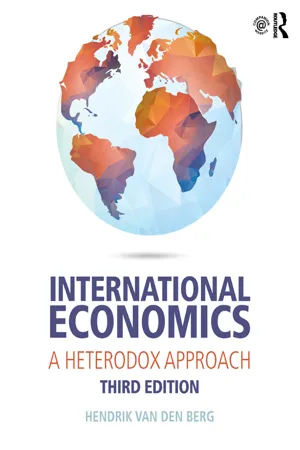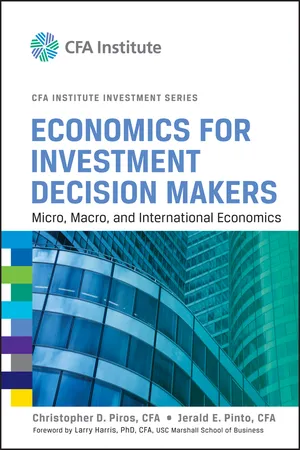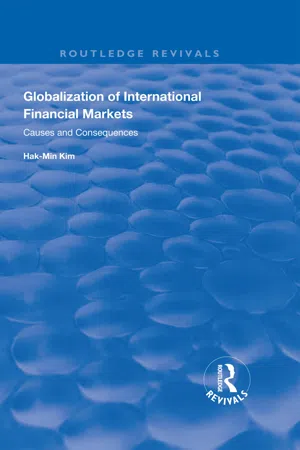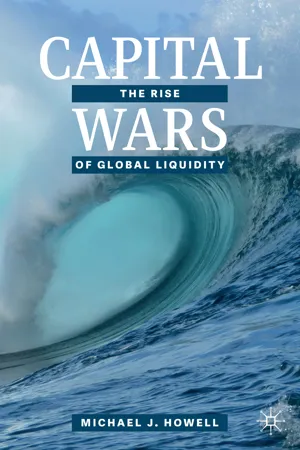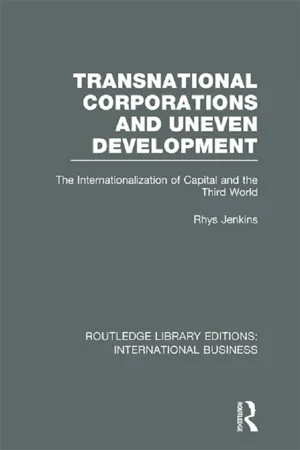Economics
International Capital Flows
International capital flows refer to the movement of money for investment purposes between countries. These flows can take the form of foreign direct investment, portfolio investment, or loans. They play a crucial role in global financial markets, influencing exchange rates, interest rates, and overall economic stability. International capital flows can have significant impacts on both sending and receiving countries' economies.
Written by Perlego with AI-assistance
Related key terms
Related key terms
1 of 4
Related key terms
1 of 3
12 Key excerpts on "International Capital Flows"
- eBook - ePub
International Economics
A Heterodox Approach
- Hendrik Van den Berg(Author)
- 2016(Publication Date)
- Routledge(Publisher)
over time, that is, transactions that involve a payment or payments in one period or periods of time in exchange for an expected, or hoped for, receipt or set of receipts in some other period or periods of time. Explicitly or implicitly, finance consists of borrowing and lending, which implies the creation of real or financial assets. International finance thus deals with those intertemporal transactions that cross borders. Of course, some international financial transactions may be related to purchases of physical capital, but the world’s international financial flows also include massive international flows of money for purchasing financial assets.The previous chapters showed how international trade has grown rapidly over the past 60 years, at least until the worldwide recession in 2007 and 2008 caused trade to decline for the first time since the close of World War II. International investment and financial flows have grown, on average, even more rapidly than trade, but their growth has been inconsistent. International investment and financial flows have fluctuated widely from year to year within all countries, and they have varied greatly among countries. Many countries, especially developing countries, often have suffered not just ups and downs in financial flows, but frequent reversals in the direction of such flows. Because such reversals cause very real reversals in economic growth and human welfare, one of the most ardent advocates of free trade, Jagdish Bhagwati, has suggested restricting International Capital Flows. In the same article from which the quote above is taken, Bhagwati (1998, p. 7) notes that “[e]ach time a crisis related to capital inflows hits a country, it typically goes through the wringer.”It is important to distinguish between investment in economic terms, which is the acquisition of physical capital, and the more popular meaning of investment - Andreas Steiner(Author)
- 2016(Publication Date)
- Academic Press(Publisher)
In the following subsections we use this definition to illustrate the magnitude of official relative to private capital. We first focus on capital flows and then turn to capital stocks.2.4.1. Capital flows
The distinction between capital inflows and outflows is based on the residency of creditor and borrower (cf. Broner et al., 2013 ). Capital inflows are defined as net purchases (difference between purchases and sales) of domestic assets by non-residents. Capital outflows equal net purchases of foreign assets by domestic agents excluding the central bank. In particular, data allow us to distinguish between foreign direct investment flows, portfolio flows and other investment flows. Hence, capital inflows are the sum of inflows of foreign direct investment in the domestic economy, inflows of portfolio investment liabilities and other investment liabilities. Accordingly, capital outflows are the sum of outflows of foreign direct investment abroad, changes in portfolio investment assets and changes in other investment assets. In our measures of inflows and outflows we do not include capital account transactions because they contain development grants and remittances, which both do not reflect investments in a narrow sense. Official flows are defined as net purchases of reserve assets by the central bank plus development aid received.Figure 2.6 shows the magnitude of capital flows for geographic regions over the period 1970–2012. A common feature across regions is the strong increase in gross capital flows between the mid-1990s and the global financial crisis of 2008–10. To better visualize them, we present two graphs for each region that use different scales: The first up to the year 2000 (Asia 1995) and the second beginning in that same year, but using a larger scale.Figure 2.6 Capital flows (in billions of US$). Notes: Capital inflows are net purchases of domestic assets by foreigners. Capital outflows equal net purchases of foreign assets by domestic agents. Official flows are defined as net purchases of reserve assets by the central bank plus development aid received.Data source:IMF (2013)- eBook - ePub
Japanese Foreign Investments, 1970-98
Perspectives and Analyses
- Dipak R. Basu, Victoria Miroshnik(Authors)
- 2019(Publication Date)
- Routledge(Publisher)
1Recent Trends in International Capital Flows
Capital flows throughout the world in recent years have become more free and flexible than ever before. Immense amounts of capital are flowing between Japan and the United States. Some significant amounts, although much less than the Japan–U.S. flows, are between the developed countries and the developing countries. The economic significance of the later capital flows on the future of the world economy can be even more significant.In the 1970s, international banks were the most important players in the international capital. Massive amounts of petrodollars were transferred between the oil-producing nations and the borrowing countries during that period. In 1996, net international banks lending was $315 billion, whereas it was only $190 billion in 1995, but now the role of the banks has become smaller than what it was twenty years ago. Although Asian countries are still major borrowers, the direct investments, mergers, and acquisitions are now more important than ever. Recently, port-folio investments in bonds and equities became very important, accounting for more than half of the private sector capital outflows from the developed countries. Official purchases of bonds can be very important at the time of exchange-rate interventions.All these capital flows are normally very volatile. These are highly sensitive to the changes in the stock markets and changes in the balance of payments of different countries. Some of these flows reflect speculative activities in the foreign exchange markets and stock markets. For example, Japan was running balance of payments surplus; thus, these inflows were not required to finance current account imbalances there. During the first six months of 1996, about U.S.$44 billion flowed into the Japanese equity market with the view that the yen would be weaker than the dollar, and, thus, the Japanese corporate sector would be revived, which did not materialized. In fact, these capital inflows made compensating central bank purchases of U.S. treasury bonds essential in order to stabilize the yen against the dollar. - eBook - ePub
Economics for Investment Decision Makers
Micro, Macro, and International Economics
- Christopher D. Piros, Jerald E. Pinto(Authors)
- 2013(Publication Date)
- Wiley(Publisher)
To identify markets that are expected to provide attractive investment opportunities, investors must analyze cross-country differences in such factors as expected gross domestic product (GDP) growth rates, monetary and fiscal policies, trade policies, and competitiveness. From a longer-term perspective investors also need to consider such factors as a country’s stage of economic and financial market development, demographics, quality and quantity of physical and human capital (accumulated education and training of workers), and its area(s) of comparative advantage. 1 This chapter provides a framework for analyzing a country’s trade and capital flows and their economic implications. International trade can facilitate economic growth by increasing the efficiency of resource allocation, providing access to larger capital and product markets, and facilitating specialization based on comparative advantage. The flow of financial capital (funds available for investment) between countries with excess savings and those where financial capital is scarce can increase liquidity, raise output, and lower the cost of capital. From an investment perspective, it is important to understand the complex and dynamic nature of international trade and capital flows because investment opportunities are increasingly exposed to the forces of global competition for markets, capital, and ideas. This chapter is organized as follows. Section 2 defines basic terminology used in the chapter and describes patterns and trends in international trade and capital flows. It also discusses the benefits of international trade, distinguishes between absolute and comparative advantage, and explains two traditional models of comparative advantage. Section 3 describes trade restrictions and their implications and discusses the motivation for, and advantages of, trade agreements - eBook - ePub
Globalization of International Financial Markets
Causes and Consequences
- Hak-Min Kim(Author)
- 2019(Publication Date)
- Routledge(Publisher)
2 Review of Literature A Brief Review of the Conceptual Approaches Most economists have been concerned with capital, but International Capital Flows did not become a major concern until relatively recently. Theories of capital flows developed in response to the internationalization of economic activities. There were four stages in this theoretical development. In the first stage, it was thought that International Capital Flows are unnecessary or disadvantageous. In The Wealth of Nations (1776), Adam Smith argued that capitalists prefer to invest their funds at home because of the uncertainty of foreign countries. 1 He warned that international capital transfer involves monopolistic behaviour by capitalists to eliminate the import of goods and to control local markets by producing the same goods in the foreign country. 2 He has little to say, however, about the determinants of International Capital Flows. In Money, Credit and Commerce (1923) Alfred Marshall supported Smith’s position that it is easier and safer to invest capital in the home country since it is easier to obtain information and to deal with legal conditions at home. He showed that domestic investments have ‘a great balance of pecuniary advantage as well as of sentimental attractiveness’ under conditions of ‘equal intrinsic merits’ of domestic and foreign capital investments. Marshall concluded that higher profit advantages by transferring capital to foreign countries and disadvantages of risks and difficulties in doing business in foreign countries are equal; thus, ‘net profits are kept nearly uniform throughout the country’ (ibid., pp. 9-11) - eBook - ePub
Capital Wars
The Rise of Global Liquidity
- Michael J. Howell(Author)
- 2020(Publication Date)
- Palgrave Macmillan(Publisher)
A stacked 3 D bar graph plots U S billion dollars versus gross inflows, gross outflows, and trade balance. The data is for trade, bank lending, F D I, and portfolio. Gross inflows have less amount for F D I than the gross outflows.Fig. 8.4Notional gross foreign sector balance sheet (illustrative)The chart tries to show that these often-hidden private sector financial flows are both active and frequently dwarf in size, as well as in volatility , parallel movements in trade flows. An increase in foreign assets describes, say, US purchases of European and Asian securities, or international lending by US banks. Similarly, a rise in foreign liabilities represents, for example, German or Japanese purchases of US stocks and bonds , and real investments by non-residents in the US economy. These movements in asset and liability flows may roughly offset one another so that net capital flows become small and insignificant, but gross asset and liability flows could still be large. Moreover, distinguishing gross flows by type identifies risk-seeking, entrepreneurial and more technology-embedded capital flows , compared to the risk-averse capital in search of safety. The former classes are more likely to promote faster economic growth. In other words, simply netting out capital flows , as implicitly happens when discussing trade and current account imbalances, loses a significant amount of information. What’s more, these capital flows may actively drive the current account , rather than passively accommodating it. For example, a large expansion in local currency bank lending to foreigners may ultimately result in faster domestic export growth. Similarly, an increase in outward FDI could itself lead to a step-up in export activity, assuming that the capital equipment is domestically manufactured. Another example, could involve a simple carry trade where an increase in foreign portfolio investment in, say, high-yielding Emerging Market debt , is financed through greater US dollar borrowing. A still more convoluted example might involve external US dollar - International Monetary Fund(Author)
- 1992(Publication Date)
- INTERNATIONAL MONETARY FUND(Publisher)
III. Direct Investment Introduction Definition Reinvestment of Earnings Description and Global Imbalances Country Practices and Adjustments Bilateral Comparisons Concluding Remarks Other Direct Investment Capital Flows Description and Global Imbalances Country Practices and Adjustments Bilateral Comparisons Concluding Remarks Data Sources and Methods Conclusions and Recommendations IV. Portfolio Investment Introduction Definition Country Practices and Adjustments Bonds Equities Bilateral Comparisons Coverage of Portfolio Transactions Private Individuals Financial Intermediaries Other Financial Institutions Concluding Remarks Stock of Cross-Border Bonds Conclusions and Recommendations V. Other Capital: Overview and Short-Term Marketable Instruments Overview of “Other Capital” in Balance of Payments Short-Term Marketable Instruments Reported Data on Short-Term Instruments Forms of Short-Term Marketable Instruments Euronotes Foreign Commercial Paper in the U.S. Market Eurodollar Certificates of Deposit Treasury Bills Conclusions and Recommendations VI. Other Capital: Nonbank Capital Flows Measured from International Banking Statistics Introduction International Banking Statistics Nonbank Transactions with Foreign Banks Nonbank Claims on Foreign Banks Nonbank Liabilities to Foreign Banks Summary Comparisons Conclusions and Recommendations VII. External Debt in Balance of Payments Data and IBRD Debt Statistics Introduction International Debt Statistics Long-Term Debt Short-Term Debt Conclusions and Recommendations VIII. Transactions in Official Reserve Assets Introduction Instrument Composition of Reserve Transactions Special Questionnaire Responses Swap Transactions in the European Monetary System Instrument Allocation of Foreign Exchange Transactions Adjustments to the Reserves/LCFAR Discrepancy Conclusions and Recommendations IX. Offshore Financial Centers- eBook - ePub
Transnational Corporations and Uneven Development (RLE International Business)
The Internationalization of Capital and the Third World
- Rhys Jenkins(Author)
- 2013(Publication Date)
- Routledge(Publisher)
5 Capital flows, accumulation and the balance of payments INTRODUCTION Although the focus of discussions of the impact of TNCs has in recent years switched to the question of technology, the effects of such firms on capital flows, local accumulation and the balance of payments is still a subject of controversy and debate. Advocates of foreign investment claim that they provide much needed finance and foreign exchange while critics stress the limited inflow of capital, the displacement of local firms and the adverse balance of payments consequences associated with TNC operations. Unlike some of the other issues discussed in this book there are close parallels between the arguments of Marxists and non-Marxists in this debate, so that it is unnecessary to distinguish between neo-classicals and neo-fundamentalists or between the Global Reach and the neo-imperialist approaches. This chapter also shows how the internationalization of capital perspective differs from the more common approaches found in the literature. Although the analysis of capital flows, effects on local accumulation and the balance of payments are clearly interrelated, for ease of exposition each will be examined separately. Finally, the issue of transfer pricing will be discussed, both because of its implication for the analysis of the balance of payments impacts of TNCs, and because it provides a clear illustration of the different approaches outlined above. CAPITAL FLOWS From the early formal model of MacDougall, neo-classical analyses of foreign investment have regarded a significant inflow of capital as almost tautological. Critics however have been quick to point out that much direct foreign investment takes place with a minimal inflow of capital from abroad. As Table 5.1 indicates, a very small proportion of the funds employed by US TNCs in less developed countries come from the United States - eBook - ePub
globalization
n. the irrational fear that someone in China will take your job
- Bruce C. Greenwald, Judd Kahn(Authors)
- 2008(Publication Date)
- Wiley(Publisher)
Notwithstanding these dramatic episodes, the overall impact of globalization in financial markets, as elsewhere, has been exaggerated. The turbulence of the late 1990s (and into 2001 if Argentina is included) has subsided. The East Asian countries seem to have succeeded in immunizing themselves against a recurrence by running sustained balance-of-payment surpluses. Like China and India, they have limited their reliance on foreign financing. Russia has benefited from high oil and other natural resource prices, removing the need and the temptation to rely on overseas sources of funds.While there is no guarantee that the pattern of events that beset South Korea and the other countries in the late 1990s will not recur (see Chapter 6), the ability of individual countries to protect themselves by forgoing extensive foreign financing should limit their frequency and magnitude.However, the capacity of countries with inadequate local savings to rely on external sources of foreign capital has been widely claimed as one of the major benefits of financial market globalization.Yet here again the impact of globalization has been exaggerated. Inflows of foreign capital can take two forms. In one, generally called portfolio investment, foreigners invest financially in a country by either making loans or buying publicly traded financial assets, including stocks, government debt, corporate bonds, local bank certificates of deposit, and other instruments. In the other form, called direct investment, foreigners invest by building factories, installing capital equipment, or otherwise developing local business enterprises. In fact, neither portfolio investment nor foreign direct investment (FDI) has been a major source of long-term financing for capital-poor or developing countries.Foreign Direct Investment: Not Where the Action Is
We might not expect FDI to be a significant source of capital for developed countries like the United States. As the figures in Table 5.1 - International Monetary Fund. Research Dept.(Author)
- 2011(Publication Date)
- INTERNATIONAL MONETARY FUND(Publisher)
CHAPTER 4 International Capital Flows: RELIABLE OR FICKLE?
Passage contains an image
What Are the Main Findings?
- The postcrisis recovery in net capital flows was more impressive in terms of its pace than its level Nevertheless, for many EMEs that were not at the center of the global crisis, levels were comparable with those during previous episodes of large net flows. The composition of the upturn was somewhat different, however, with a higher share of debt-creating flows and a lower share of foreig direct investment (FDI) compared with historical trends.
- Net flows have become slightly more volatile for all economies over time. They also exhibit low persistence. The volatility of net flows is generally higher in EMEs and other developing economies (ODEs) than in AEs. By contrast, there are no obvious differences in the persistence of net flows across economies. Bank and other private flows have typically been the most volatile, and portfolio debt the least persistent, but the differences in volatility and persistence across types of flow are not always statistically significant for all economies. FDI is only slightly more stable and more persistent than debt-creating flows to EMEs.
- Historically, net flows to EMEs have tended to be higher under low global interest rates, low global risk aversion, and stronger growth performance in EMEs compared with AEs. The pattern is most pro nounced when global interest rates and risk aversion are both low. Nevertheless, common factors—both global and regional—account for a relatively small share of the total variation in net flows to EMEs, highlighting the importance of domestic factors.
- Advanced and emerging market economies that are directly financially exposed to the United States face an additional decline in their net capital flows in response to U.S. monetary policy tightening over and above what is experienced by economies with no such U.S. direct financial exposure. The negative additional effect of a hike in the U.S. rate that is unanticipated is larger than that of a realized rate increase. Thus, positive U.S. monetary policy surprises may induce investors to revise up their expectations for future U.S. monetary policy, thereby resulting in a sharper retrenchment of their positions in economies that are directly financially exposed to the United States than under actual U.S. monetary policy changes that were partly or wholly anticipated. This negative additional effect for financially exposed EMEs is larger for EMEs that are more integrated with global financial markets and those with relatively flexible exchange rate regimes, but smaller for EMEs with greater domestic financial depth and strong growth performance. Finally, of particular relevance to today’s environment is the finding that the negative additional effect on net flows to financially exposed EMEs due to U.S. monetary policy tightening is larger during periods of low global interest rates and low global risk aversion. This may reflect the fact that cross-border investors are more likely to chase returns when global financial asset returns are low and risk appetite is high.
- (Author)
- 2019(Publication Date)
- Wiley(Publisher)
However, investment/financing decisions are usually the dominant factor in determining exchange rate movements, at least in the short to intermediate term. There are four main reasons for this:- Prices of real goods and services tend to adjust much more slowly than exchange rates and other asset prices.
-
Production of real goods and services takes time, and demand decisions are subject to substantial inertia. In contrast, liquid financial markets allow virtually instantaneous redirection of financial flows.
-
Current spending/production decisions reflect only purchases/sales of current production, while investment/financing decisions reflect not only the financing of current expenditures but also the reallocation of existing portfolios.
-
Expected exchange rate movements can induce very large short-term capital flows. This tends to make the actual exchange rate very sensitive to the currency views held by owners/managers of liquid assets.
5.1 . Current Account Imbalances and the Determination of Exchange Rates
Current account trends influence the path of exchange rates over time through several mechanisms:- The flow supply/demand channel
- The portfolio balance channel
- The debt sustainability channel
5.1.1 . The Flow Supply/Demand Channel
The flow supply/demand channel is based on a fairly simple model that focuses on the fact that purchases and sales of internationally traded goods and services require the exchange of domestic and foreign currencies in order to arrange payment for those goods and services. For example, if a country sold more goods and services than it purchased (i.e., the country was running a current account surplus), then the demand for its currency should rise, and vice versa. Such shifts in currency demand should exert upward pressure on the value of the surplus nation’s currency and downward pressure on the value of the deficit nation’s currency.- International Monetary Fund. Research Dept.(Author)
- 2013(Publication Date)
- INTERNATIONAL MONETARY FUND(Publisher)
In 2011 policymakers worried that excessive inflows might cause overheating, but more recently concerns have shifted to the disruption that might result from sudden stops as interest rates in the United States normalize. A key question for many policymakers is how best to respond to the challenges such volatile capital inflows present. As illustrated in Box 4.1 and discussed in other research from the IMF, capital flow management measures and foreign exchange intervention can be useful in moderating the volatility of capital flows and exchange rates in less resilient emerging market economies in some circumstances. 22 But policymakers are not limited to these tools. Policymakers can implement important reforms that can help increase the resilience of their economies to swings in gross inflows by encouraging stabilizing financial adjustment. Such adjustment means that swings in gross inflows need not necessarily translate into disruptive fluctuations in the current account. Rather, when gross capital inflows increase, residents will tend to offset these flows by accumulating foreign assets that are later repatriated when foreign inflows decline. And this chapter documents how countries with such greater financial adjustment better withstood the sharp contraction in gross inflows during the global financial crisis, experiencing a smaller fall in both GDP and consumption. The particular reforms and characteristics that appear to have supported stabilizing financial adjustment are highlighted in the empirical analysis and case studies. A first important characteristic is the strength of their institutional frameworks. 23 In particular, resilient emerging market economies have more credible fiscal and monetary policies that are used countercyclically. In this regard, it is important to note that countercyclical fiscal measures should not be used only in downturns, when some emerging market economies may actually be limited in their ability to finance a fiscal stimulus
Index pages curate the most relevant extracts from our library of academic textbooks. They’ve been created using an in-house natural language model (NLM), each adding context and meaning to key research topics.
Explore more topic indexes
Explore more topic indexes
1 of 6
Explore more topic indexes
1 of 4
